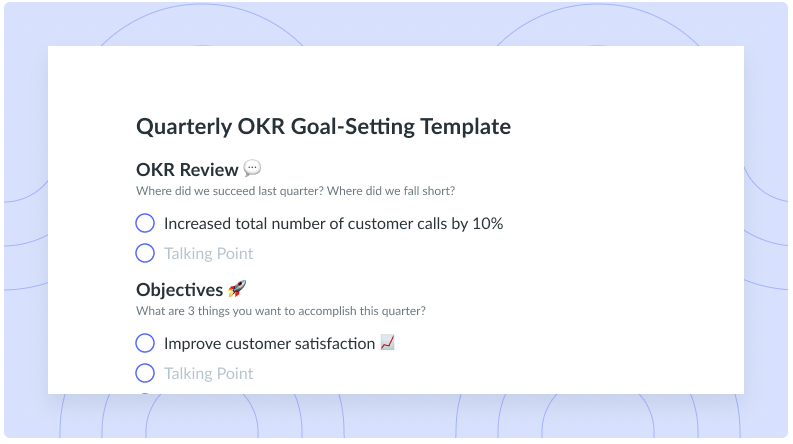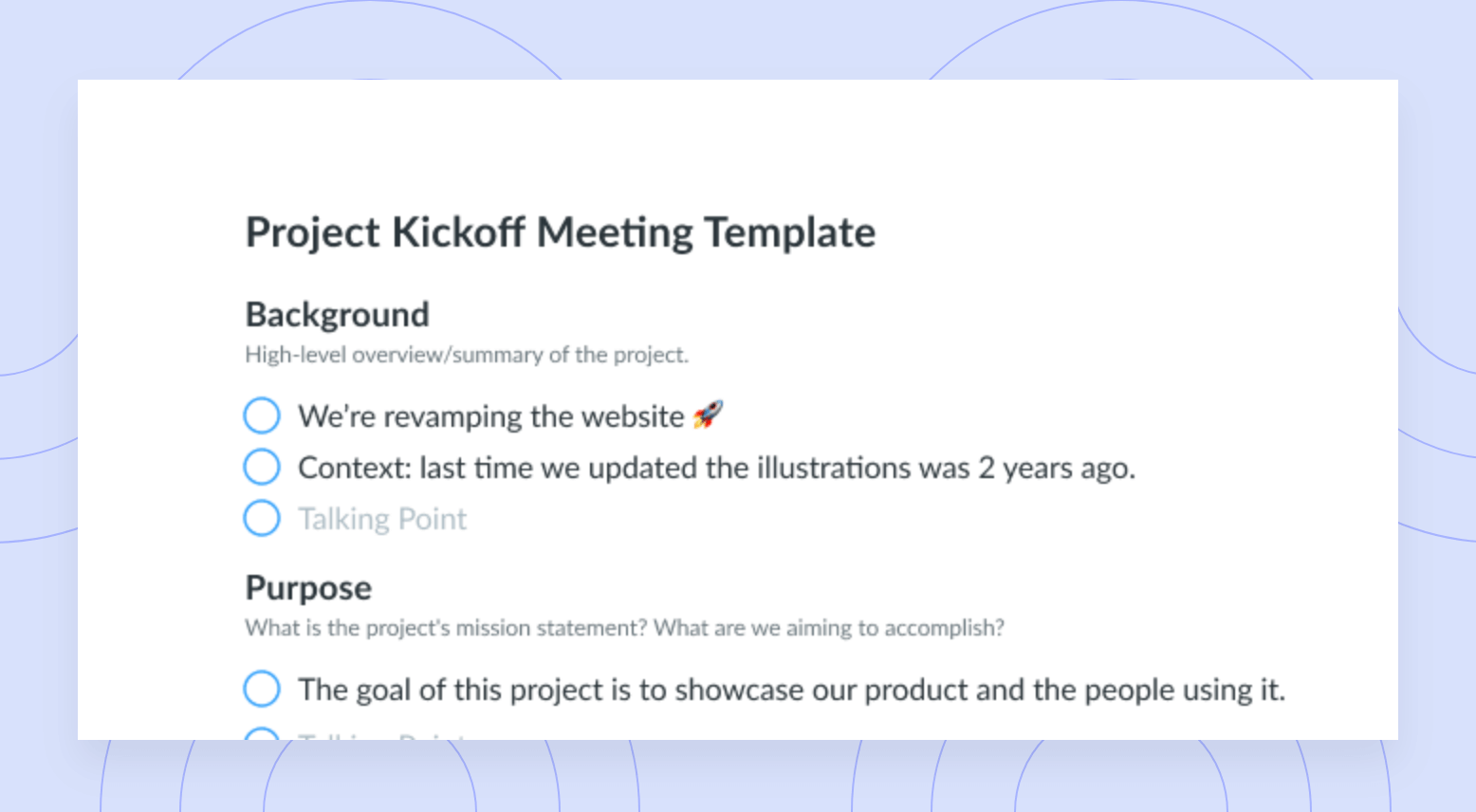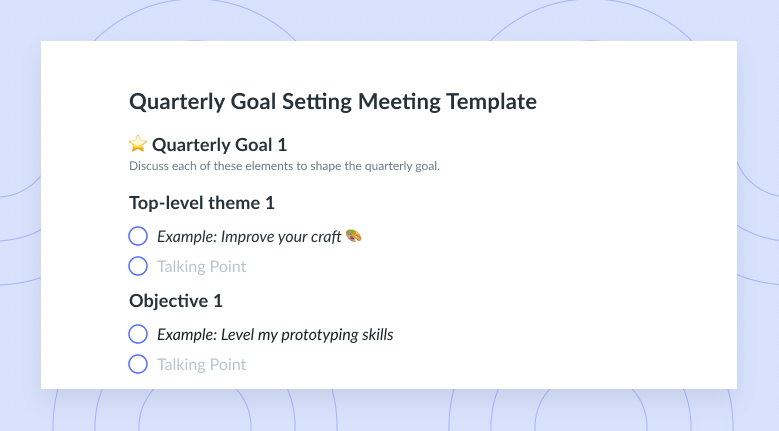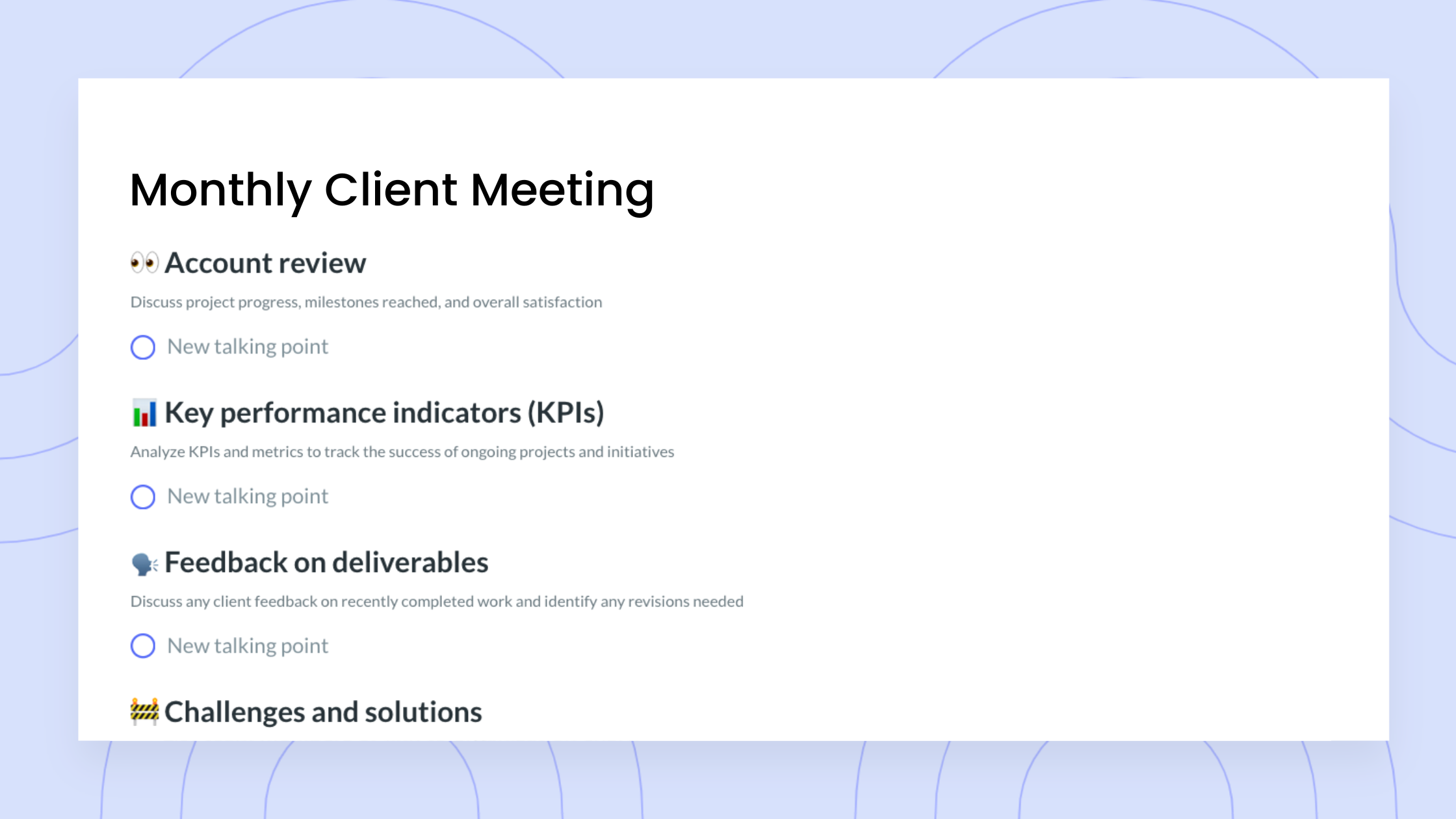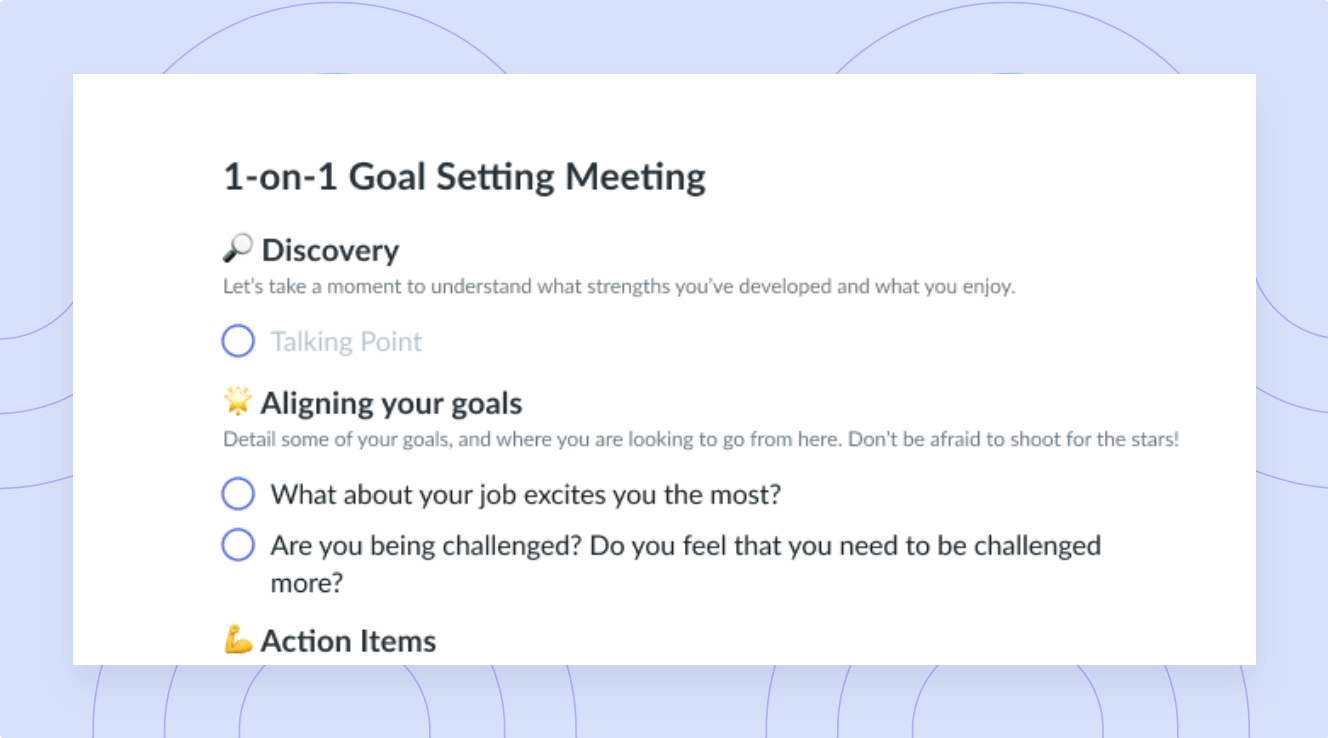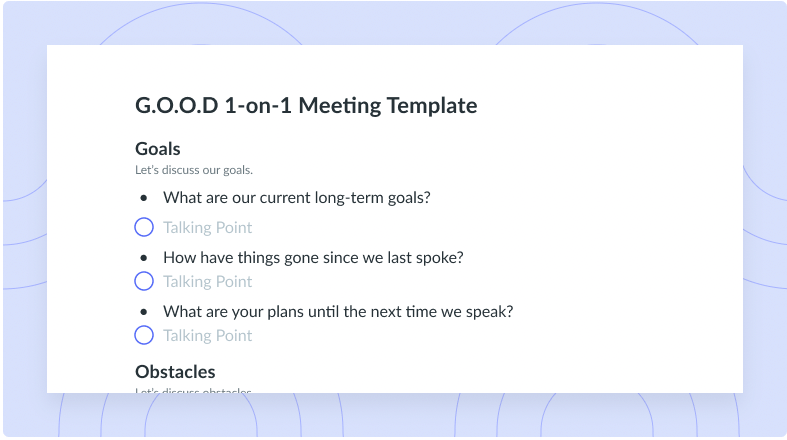How to Write Project Objectives: Tips, Tricks & Examples
Dive into our guide on setting effective project objectives for successful project management, featuring actionable tips and examples.
Whether you’re discussing an upcoming project in a quick huddle or a game-changing meeting, setting project objectives can make all the difference. With the right project objectives, you can ensure your team members are on the same page about your organization’s long-term goals. If everyone has a clear picture of your objectives, they’ll be well prepared to complete your next project efficiently and effectively. Keep reading to learn about project objectives—what they are, how to set them, and how to use them to amp up your project management.
- What are project objectives, and why are they important?
- Tips for writing effective project objectives
- Examples of project objectives
- Differentiating project objectives from project management terms
What are project objectives, and why are they important?
Simply put, project objectives represent what you want to get out of a project. When you’re brainstorming your objectives, think about the best possible (but still realistic) outcome of your project—and be specific, too. Maybe you want to increase your organization’s social page engagement by 20 percent or hope to be carbon-neutral in the next five years. In any case, project objectives can keep your team clear on what to strive for throughout a project.
Setting project objectives is a key step in maximizing the outcome of your project. That’s because great objectives help you set parameters for how and when your team will get the job done. You can use your objectives to build a realistic timeline for your project or show how each team member will contribute.
Most importantly, project objectives help you and your team envision a successful project. With a clear picture in mind, everyone can keep their eye on the prize.

Create objectives that stick
Fellow seamlessly integrates objectives and key results into everyone’s meetings so they’re always top of mind, trackable, and part of discussions and decisions.
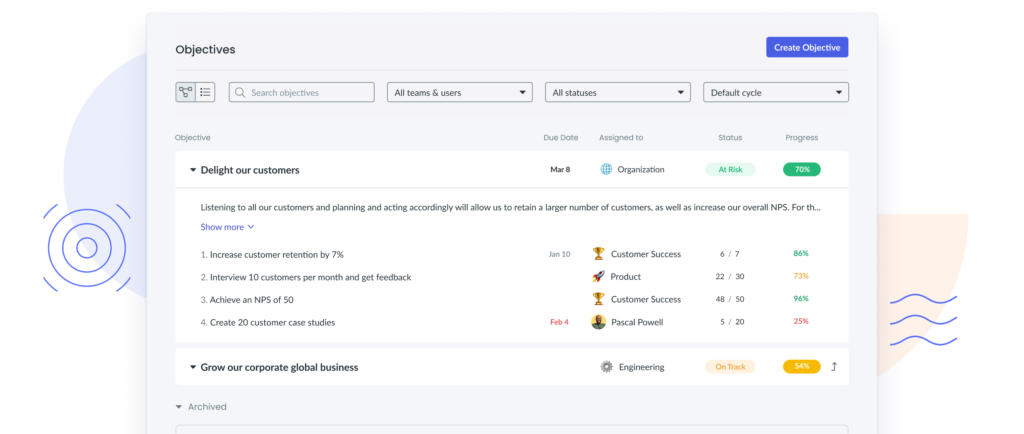
Tips for writing effective project objectives
The following are some of the top strategies for coming up with effective project objectives.
- Make them SMART objectives
- Get all hands on deck
- Work in some numbers
- Learn from the past
- Stay mission-driven
- Keep them simple
- Think long term
Make them SMART objectives
When drafting project objectives, follow the SMART goal-setting method. SMART, which stands for specific, measurable, achievable, relevant, and time-bound, is a great way to create clear, in-depth objectives. If you write each of your objectives as SMART statements, you’ll be well on your way to upping your project management game.
Get all hands on deck
Writing project objectives should be a collaborative process. After all, your team members are the biggest experts in their own capacities.
To stop yourself from drafting objectives that are too lofty or impossible to achieve, get input from everyone involved. From executives’ big-picture corporate goals to junior staff members’ ideas to keep things running smoothly, make sure you’re hearing every voice.
Work in some numbers
One of the best ways to clear up confusion about your project objectives is to work in concrete numbers. For example, everyone might have a different idea of what “outstanding customer service” means. Setting a project objective of five stars across 90% of reviews, though, will keep things clear. Plus, if you set an ambitious numerical benchmark, your team will be motivated to clear it—and celebrate a big win.
Learn from the past
Looking at your key performance indicators (KPIs) and past projects is one of the best ways to determine what objectives are relevant and achievable. These metrics can also serve as a framework for how—and when—to make your project objectives more ambitious. If your organization has faced challenges meeting goals in the past, then you might want to make your project objectives more realistic. But if your team cleared last quarter’s KPIs with ease, it might be time to aim higher.
Stay mission-driven
Each project objective you draft should reflect your organization’s mission and vision statements. When writing a project objective, make sure to ask yourself how the project will serve these broader goals. Think of each project as a stepping stone in getting your organization closer to achieving its mission. If you can’t think of how a project objective serves these big-picture goals, it might be time to pivot.
Keep them simple
When it comes to writing project objectives, the less complicated, the better. Since you want to get everyone on your team on the same page, your best bet is to write objectives that are easily digestible. You want to create objectives that everyone involved in a project across departments and divisions will understand quickly.
With Fellow, you can simplify setting project objectives by making it easy to define objectives with assignees, due dates, statuses, and progress against set key results. You can also easily review the objectives during meetings, enhancing project accountability and transparency.
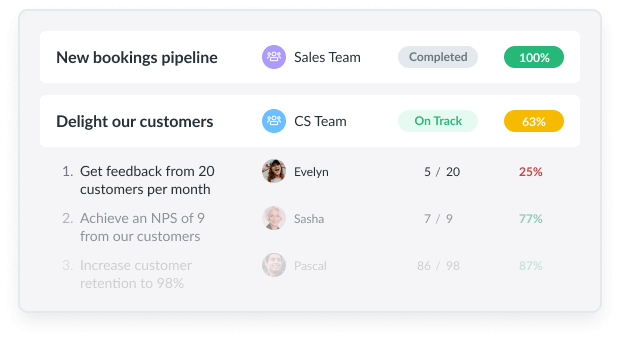
Think long term
One of the biggest benefits of project objectives is that they serve as building blocks for the future. Each project your team completes should move your organization forward, whether that means streamlining future processes or setting new problem-solving standards. For any long-term challenges you’re looking to tackle, your project objectives can help you get there.
Examples of project objectives
Below are examples of some of the most common types of project objectives.
- Business project objectives
- Effectiveness project objectives
- Customer satisfaction project objectives
Business project objectives
What they are: A business project is anything that will change the landscape of how your organization operates. For everything from launching new products to closing old locations, business projects clearly contribute, in some way, to your organization’s big-picture goals. Business project objectives can help you measure, as clearly as possible, how to make the most of these developments. As you’re writing a business project objective, consider where you want your organization to be after you complete the project.
Example:
Suppose you’re remodeling one of your less successful products. You might set a business project objective to get 15 longtime customers’ feedback on your new product design by year-end.
Effectiveness project objectives
What they are: If you’re looking to step up your internal problem-solving, then an effectiveness project objective can make all the difference. Effectiveness project objectives measure how quickly, accurately, and effectively your team can complete a project.
Sometimes, a project gets held up simply because people aren’t clear on their roles or responsibilities or are not communicating with other departments. In either case, measuring effectiveness during project management can help you uncover any hiccups along the way. Many effectiveness project objectives include setting timed benchmarks for completing certain tasks.
Example:
You might want to establish weekly checkpoints where each involved department should report completing one deliverable. Stated as an objective, this would read: “Hold checkpoints every Wednesday at 3 p.m., during which we record and approve one deliverable from each department.”
Customer satisfaction project objectives
What they are: While effectiveness project objectives focus on your organization’s internal processes, customer satisfaction project objectives center around the external face of your business. When you’re drafting up a customer satisfaction project objective, think about the biggest pain points in your customer interfaces and interactions. Then, think of material objectives for solving these issues.
Example:
Imagine that you want to increase your organization’s average online review rating from 3.5 to 4.5 stars by year-end. You might set an objective to identify three common complaints and develop solutions for each, with a 0.1-star increase in average rating per month.
Differentiating project objectives from project management terms
There’s a precise space where objectives fit into the world of project management. Keep reading to learn more about how to distinguish project objectives from other related terms.
- Project objectives vs. project deliverables
- Project objectives vs. project plan
- Project objectives vs. project goals
- Project objectives vs. business objectives
- Project objectives vs. project milestones
Project objectives vs. project deliverables
If project objectives outline the expected outcomes of a project, project deliverables are what you produce to make the outcomes happen. Some examples of project deliverables include customer analytics reports and fully drafted marketing strategies.

Focus on the right action items
Fellow makes it easy to visualize and organize your upcoming action items and deliverables, so you can focus on your priorities and start each day feeling in control.
Project objectives vs. project plan
Where a project objective focuses on outcomes, your project plan involves all the moving parts for getting it done. In your plan, consider all outside stakeholders’ objectives, decide which teams are involved, and determine how much time they have to complete each task. Include any project constraints, including a short timeline, a low budget, or a small team.
Project objectives vs. project goals
Project goals are the long-term, big-picture milestones your organization works toward. Project objectives are the SMART versions of these goals. Some common examples of project goals include increasing your bottom line, improving employee retention rates, and improving customer service methods. A project objective for the latter, though, would be much more detailed. It might look like this: “During this quarter, get 80% of callers to express satisfaction with our customer service in post-call surveys.”
Project objectives vs. business objectives
Not to be confused with business project objectives, business objectives represent your organization’s long-term goals—they’re bigger than any one project. Project objectives might help you get closer to your business objectives, but they’re only one part of the process of improving your organization. Popular business objectives include beating competitors, reaching revenue records, and decreasing manufacturing costs.
Project objectives vs. project milestones
Project milestones make up the critical checkpoints your team needs to hit when achieving a project objective. You can plan out project milestones in advance, such as scheduling a launch date for your organization’s new web page. Reaching project milestones can indicate that your organization is on track to blow your project objectives out of the water.
Parting advice
Project objectives help you and your team make the most of your time and achieve your goals as effectively as possible. With the right objectives, you can get your organization on the same page about what makes for a successful project. You’ll clear up any confusion about the desired outcome of a project and confirm that each team member knows the best ways to contribute. Use Fellow’s project meeting agenda templates to allow all team members to weigh in on, absorb, and get enthusiastic about your project objectives!
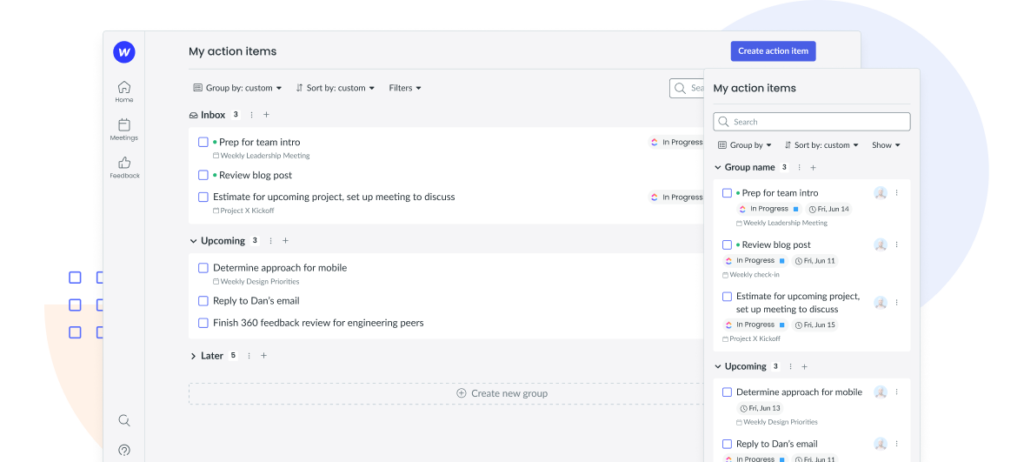






![Management by Objectives (MBO) Strategy: 5 Steps [+Example]](https://fellow.app/wp-content/uploads/2023/06/Management-by-objectives-MBO2.jpg)


